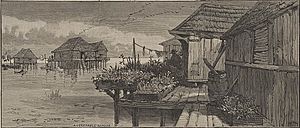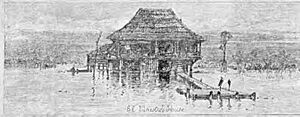Saint Malo, Louisiana facts for kids
Quick facts for kids
Saint Malo
San Maló (Spanish)
|
|
|---|---|

The settlement as it appeared in Harper's Weekly, 1883.
|
|
| Country | United States |
| State | Louisiana |
| Parish | St. Bernard Parish |
| Establishment | likely 18th century |
| Destruction | September 29, 1915 |
| Named for | Juan San Maló |
| Time zone | UTC−6 (Central) |
| • Summer (DST) | UTC−5 (Central) |
Saint Malo (also known as San Maló in Spanish) was a small fishing village in St. Bernard Parish, Louisiana. It was located along the shore of Lake Borgne. This village was special because it was the first permanent settlement of Filipinos in the United States. It might even have been the first Asian-American settlement in the country.
Saint Malo was likely formed as early as 1763 or 1765. It was settled by Filipino sailors who left the Spanish Manila galleon trade. Some escaped slaves also joined them. The people in this community were often called Manila men or Manilamen. Later, they were known as Tagalas. The village existed until a big storm, the 1915 New Orleans hurricane, destroyed it.
Contents
What's in a Name?
The area of Saint Malo is named after a brave leader named Jean Saint Malo. In 1784, he led a group of enslaved Africans who had escaped. They found safety in a marshy area near Lake Borgne. They even got weapons from other free people of color and slaves.
Sadly, Jean Saint Malo was captured by Spanish forces. On June 19, 1784, he was put to death in front of St. Louis Cathedral in New Orleans. This spot is now called Jackson Square.
Where Was Saint Malo?
Saint Malo was located on a waterway called Saint Malo Bayou. This was about 5 miles (8 km) east of another fishing village, Shell Beach.
How the Village Started
Some stories say that the Saint Malo settlement began around 1763. It was founded by Filipinos who left Spanish ships. These ships were part of the Manila galleon trade. They wanted to escape harsh treatment from the Spanish.
These Filipinos settled in the marshlands of Louisiana. This was a place where the Spanish could not easily reach them. The people who lived in these bayou areas were called Manilamen. They later became known as Tagalas. For over a hundred years, they lived by their own rules. They kept their community a secret from the rest of society.
Their existence became known to the American public in 1883. This happened when a journalist named Lafcadio Hearn wrote an article. It was published in Harper's Weekly. Hearn's article was the first known story about Filipinos living in the United States.
Homes in the Swamps
Lafcadio Hearn visited the village and wrote about their homes. The Manilamen lived in small houses built on stilts above the water. The local plants, like palmetto and woven cane, were not strong enough for building. So, they had to bring in stronger wood from other parts of Louisiana.
Life in the swamps meant dealing with many creatures. The villagers put wire netting on all their windows. This kept out mosquitoes and other insects. They also had to watch out for reptiles and other animals. Inside their homes, there was no furniture like tables, chairs, or beds. They used what Hearn called "dry Spanish-beard" (likely Spanish moss) as mattresses. These were placed on shelves along the walls. Fishermen often slept among barrels of flour, folded sails, and smoked fish.
Daily Life
What They Ate
The main food in the village was fish. They rarely ate rice, even though it is a very common food for Filipinos.
Their Beliefs
Most Manilamen followed Roman Catholicism. It's not known if a priest from New Orleans ever visited the village. So, they might not have had regular Christian services or sacraments.
How They Governed Themselves
The Manilamen did not pay taxes and had no policemen. They made their own rules and laws, and everyone in the village had to follow them. If there was a disagreement, the oldest man in the village would help solve it. If someone refused to follow a decision or caused problems, they were put in a "fish-car." This was a simple jail cell. Because conditions were tough and food was scarce, offenders usually changed their minds quickly. No government officials from Louisiana ever visited the village, even though it was part of St. Bernard Parish.
Families
Women rarely lived in the village. When Hearn visited, there were no women there. Fishermen who had families usually had them live in New Orleans or other towns. This was because the village was isolated and life there was very hard. Since there were no Filipino women, the Manilamen often married Cajun women, Native Americans, or others. Some even sent their children to schools in New Orleans.
If they could, the Manilamen would send money back to their families in the Philippines. They used the money they earned from fishing to help their loved ones.
Role in the War of 1812
Stories passed down through generations say that the Manilamen helped in the Battle of New Orleans in 1815. This battle was part of the War of 1812. These men joined the privateer Jean Lafitte and fought with Major General Andrew Jackson's army.
In late 1814, a large British army planned to capture New Orleans. Jackson's American forces included regular soldiers, local militia, and sharpshooters. It is believed that many of the "pirates" who joined Jackson were the Manilamen. They were described as "Spanish fishermen" from the Lake Borgne area. At that time, the Manilamen were the only known Spanish-speaking fishermen in that region, besides the Isleños.
The End of Saint Malo
The community of Saint Malo was destroyed by the 1915 New Orleans hurricane in 1915. The people who survived moved to New Orleans and became part of that community.
Other Filipino Settlements
Saint Malo was not the only Filipino settlement in the Southern United States. Other villages in Louisiana included Manila Village on Barataria Bay, Alombro Canal and Camp Dewey in Plaquemines Parish, and Leon Rojas, Bayou Cholas, and Bassa Bassa in Jefferson Parish.
Manila Village on Barataria Bay was the largest and most well-known. However, Saint Malo was the oldest. Manila Village had houses built on stilts over 50 acres of marshland. It lasted until 1965, when Hurricane Betsy destroyed it. Filipinos in Louisiana also helped develop the production of dried shrimp. This is still a tradition among the Cajuns of Louisiana today.
Some people living in Louisiana today are descendants of these early Filipino settlers. They are part of the diverse multiracial American community.
Notable Filipino Settlements in Louisiana
- Alombro Canal (Plaquemines Parish)
- Camp Dewey (Plaquemines Parish)
- Bayou Cholas (Jefferson Parish)
- Bassa Bassa (Jefferson Parish)
- Leon Rojas (Jefferson Parish)
- Manila Village (Jefferson Parish)
Images for kids





